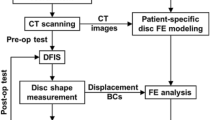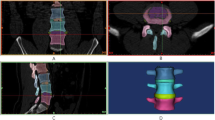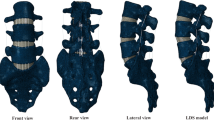Abstract
Introduction
The presence of degeneration alters the stress within that particular degenerated disc. Therefore, the state of degeneration of the disc at the level adjacent to a single level fusion would influence the rate of subsequent further degeneration of that same adjacent disc. Therefore, the purpose of this study was to investigate the biomechanical effect of the disc degeneration at the adjacent segment on the stress of the corresponding segment after one segment lumbar fusion using validated finite element (FE) models.
Method
Three validated L2–L5 FE models with different grades of disc degeneration (normal, mild, moderate) at the L2–L5 were simulated. Based on the intact models that represented each grade of disc degeneration, the matched L3–L4 instrumented fusion models were developed. Therefore, three intact models and three matched fusion models were simulated. Under the 400-N pre-compressive follower loading, 7.5 Nm moments simulating flexion, extension, lateral bending, and torsion in five steps were imposed on the L2 superior endplate of three intact models. The hybrid loading protocol was utilized for the fusion models. The intradiscal pressure and the maximal von Mises stress of the annulus fibrosus in the L2–L3 and L4–L5 segments were analyzed and compared between fusion and intact models with each grade of disc degeneration.
Results
Disc degeneration led to an increase of maximal von Mises stress of annulus fibrosus at this degenerated disc, related to disc degeneration under flexion, extension, lateral bending and torsion moments. Furthermore, the fusion also increased a maximal von Mises stress of annulus fibrous at both proximal and distal adjacent segments under hybrid protocol. The increases of annular stress were greater at the proximal adjacent segment than those at distal adjacent segment. However, the contribution of the fusion surgery to the increment rate of annulus fibrosus stress at the adjacent segment did not increase in relation with disc degeneration states at the adjacent segment.
Conclusion
The present study demonstrates disc degeneration per se and fusion can cause the increase of disc stress at the adjacent segment. However, they seem not to act synergistically. Therefore, the proper decision of fusion extent needs comprehensive individual considerations about the degree of facet degeneration, canal stenosis and patient’s activity.







Similar content being viewed by others
References
Bono CM, Lee CK (2004) Critical analysis of trends in fusion for degenerative disc disease over the past 20 years: influence of technique on fusion rate and clinical outcome. Spine 29(4):455–463 (discussion Z455)
Park P, Garton HJ, Gala VC, Hoff JT, McGillicuddy JE (2004) Adjacent segment disease after lumbar or lumbosacral fusion: review of the literature. Spine 29(17):1938–1944
Rahm MD, Hall BB (1996) Adjacent-segment degeneration after lumbar fusion with instrumentation: a retrospective study. J Spinal Disord 9(5):392–400
Cheh G, Bridwell KH, Lenke LG, Buchowski JM, Daubs MD, Kim Y, Baldus C (2007) Adjacent segment disease following lumbar/thoracolumbar fusion with pedicle screw instrumentation: a minimum 5-year follow-up. Spine 32(20):2253–2257
Massey CJ, van Donkelaar CC, Vresilovic E, Zavaliangos A, Marcolongo M (2012) Effects of aging and degeneration on the human intervertebral disc during the diurnal cycle: a finite element study. J Orthop Res 30(1):122–128
Chen S-H, Zhong Z-C, Chen C-S, Chen W-J, Hung C (2009) Biomechanical comparison between lumbar disc arthroplasty and fusion. Med Eng Phys 31(2):244–253
Goel VK, Kim YE, Lim TH, Weinstein JN (1988) An analytical investigation of the mechanics of spinal instrumentation. Spine 13(9):1003–1011
Kim Y (2007) Finite element analysis of anterior lumbar interbody fusion: threaded cylindrical cage and pedicle screw fixation. Spine 32(23):2558–2568
Pintar FA, Yoganandan N, Myers T, Elhagediab A, Sances A (1992) Biomechanical properties of human lumbar spine ligaments. J Biomech 25(11):1351–1356
Polikeit A, Ferguson SJ, Nolte LP, Orr TE (2003) Factors influencing stresses in the lumbar spine after the insertion of intervertebral cages: finite element analysis. Eur Spine J 12(4):413–420
Shirazi-Adl A, Ahmed AM, Shrivastava SC (1984) A finite element study of a lumbar motion segment subjected to pure sagittal plane moments. J Biomech 19:331–350
Wu HC, Yao RF (1976) Mechanical behavior of the human annulus fibrosus. J Biomech 9(1):1–7
Schmidt H, Galbusera F, Rohlmann A, Zander T, Wilke H-J (2012) Effect of multilevel lumbar disc arthroplasty on spine kinematics and facet joint loads in flexion and extension: a finite element analysis. Eur Spine J 21(Suppl 5):S663–S674
Ruberté LM, Natarajan RN, Andersson GB (2009) Influence of single-level lumbar degenerative disc disease on the behavior of the adjacent segments-a finite element model study. J Biomech 42:341–348
Benneker LM, Heini PF, Anderson SE, Alini M, Ito K (2005) Correlation of radiographic and MRI parameters to morphological and biochemical assessment of intervertebral disc degeneration. Eur Spine J 14(1):27–35
Hartmann F, Janssen C, Böhm S, Hely H, Rommens PM, Gercek E (2012) Biomechanical effect of graded minimal-invasive decompression procedures on lumbar spinal stability. Arch Orthop Trauma Surg 132(9):1233–1239
Adams MA, McNally DS, Dolan P (1996) ‘Stress’ distributions inside intervertebral discs. The effects of age and degeneration. J Biomech Eng 78(6):965–972
Acaroglu ER, Iatridis JC, Setton LA, Foster RJ, Mow VC, Weidenbaum M (1995) Degeneration and aging affect the tensile behavior of human lumbar anulus fibrosus. Spine 20(24):2690–2701
Elliott DM, Setton LA (2001) Anisotropic and inhomogeneous tensile behavior of the human anulus fibrosus: experimental measurement and material model predictions. J Biomech Eng 123(3):256–263
Umehara S, Tadano S, Abumi K, Katagiri K, Kaneda K, Ukai T (1996) Effects of degeneration on the elastic modulus distribution in the lumbar intervertebral disc. Spine 21(7):811–819 (discussion 820)
Ha K-Y, Lee J-S, Kim K-W (2009) Bone graft volumetric changes and clinical outcomes after instrumented lumbar or lumbosacral fusion: a prospective cohort study with a five-year follow-up. Spine 34(16):1663–1668
Schilling C, Krüger S, Grupp TM, Duda GN, Blömer W, Rohlmann A (2011) The effect of design parameters of dynamic pedicle screw systems on kinematics and load bearing: an in vitro study. Eur Spine J 20(2):297–307
Wilke H-J, Heuer F, Schmidt H (2009) Prospective design delineation and subsequent in vitro evaluation of a new posterior dynamic stabilization system. Spine 34(3):255–261
Mimura M, Panjabi MM, Oxland TR, Crisco JJ, Yamamoto I, Vasavada A (1994) Disc degeneration affects the multidirectional flexibility of the lumbar spine. Spine 19(12):1371–1380
Rohlmann A, Zander T, Schmidt H, Wilke H-J, Bergmann G (2006) Analysis of the influence of disc degeneration on the mechanical behaviour of a lumbar motion segment using the finite element method. J Biomech 39(13):2484–2490
Patwardhan AG, Havey RM, Meade KP, Lee B, Dunlap B (1999) A follower load increases the load-carrying capacity of the lumbar spine in compression. Spine 24(10):1003–1009
Schmidt H, Shirazi-Adl A, Galbusera F, Wilke HJ (2010) Response analysis of the lumbar spine during regular daily activities––a finite element analysis. J Biomech 43(10):1849–1856. doi:10.1016/j.jbiomech.2010.03.035
O'Connell GD, Vresilovic EJ, Elliott DM (2011) Human intervertebral disc internal strain in compression: the effect of disc region, loading position, and degeneration. J Orthop Res 29:547–555
Sato K, Kikuchi S, Yonezawa T (1999) In vivo intradiscal pressure measurement in healthy individuals and in patients with ongoing back problems. Spine 24(23):2468–2474
Galbusera F, Schmidt H, Neidlinger-Wilke C, Wilke H-J (2011) The effect of degenerative morphological changes of the intervertebral disc on the lumbar spine biomechanics: a poroelastic finite element investigation. Comput Methods Biomech Biomed Eng 14(8):729–739
Goel VK, Grauer JN, Patel T, Biyani A, Sairyo K, Vishnubhotla S, Matyas A, Cowgill I, Shaw M, Long R, Dick D, Panjabi MM, Serhan H (2005) Effects of charite artificial disc on the implanted and adjacent spinal segments mechanics using a hybrid testing protocol. Spine (Phila Pa 1976) 30(24):2755–2764
Rohlmann A, Neller S, Bergmann G, Graichen F, Claes L, Wilke HJ (2001) Effect of an internal fixator and a bone graft on intersegmental spinal motion and intradiscal pressure in the adjacent regions. Eur Spine J 10(4):301–308
Weinhoffer SL, Guyer RD, Herbert M, Griffith SL (1995) Intradiscal pressure measurements above an instrumented fusion. A cadaveric study. Spine 20(5):526–531 (Phila Pa 1976)
Acknowledgments
This study was supported by the Grant No. 02-2012-061 from SNUBH Research Fund.
Conflict of interest
The authors state that there are no conflict of interest.
Author information
Authors and Affiliations
Corresponding author
Additional information
H.-J. Kim and K.-T. Kang have contributed equally to this work.
Rights and permissions
About this article
Cite this article
Kim, HJ., Kang, KT., Chun, HJ. et al. The influence of intrinsic disc degeneration of the adjacent segments on its stress distribution after one-level lumbar fusion. Eur Spine J 24, 827–837 (2015). https://doi.org/10.1007/s00586-014-3462-0
Received:
Revised:
Accepted:
Published:
Issue Date:
DOI: https://doi.org/10.1007/s00586-014-3462-0




